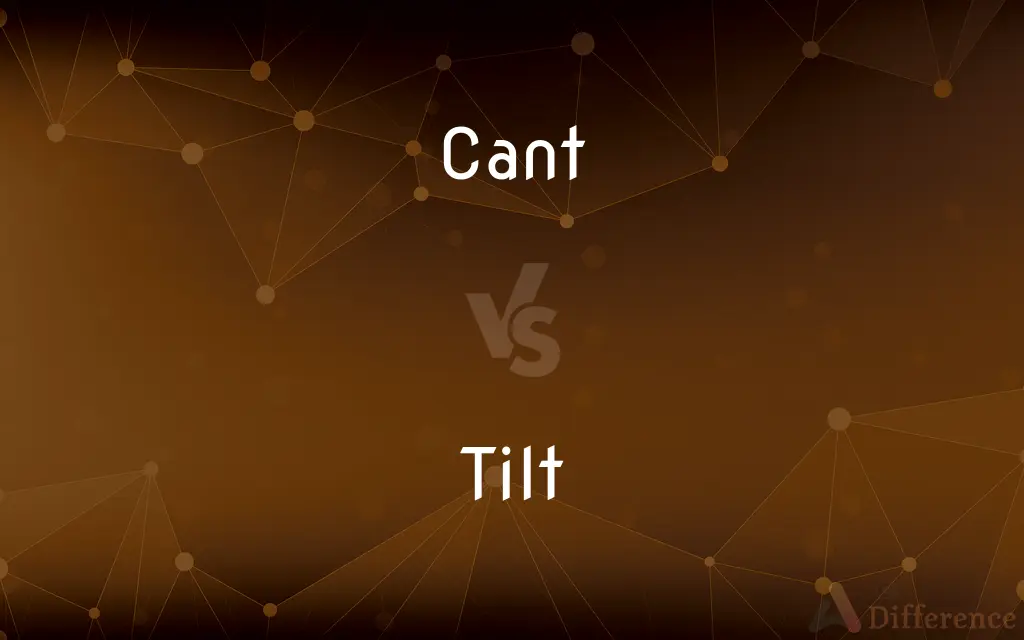Cant vs. Tilt — What's the Difference?
By Urooj Arif & Fiza Rafique — Updated on April 4, 2024
Cant refers to an angle or slant from the vertical or horizontal, often used in structural contexts, while tilt implies a leaning or incline, typically suggesting movement or adjustment.

Difference Between Cant and Tilt
Table of Contents
ADVERTISEMENT
Key Differences
Cant is often used to describe a fixed or inherent angle, particularly in architecture or design, such as the cant of a roof or roadway, indicating a purposeful slant for drainage or stability. Tilt, on the other hand, usually refers to an action or condition where an object is moved from its original axis, implying a dynamic or temporary state, like tilting a picture frame for a better view.
In engineering and construction, cant might refer to the deliberate angling of elements to achieve certain structural or aesthetic objectives, emphasizing a planned and permanent feature. Tilt, however, suggests a deviation from the standard or expected alignment, often used in contexts where adjustment or correction is possible or necessary.
Cant can also imply a bias or viewpoint, particularly in discussions or narratives, hinting at a figurative 'leaning' towards one side of an argument. Whereas tilt is more commonly associated with physical objects or spaces, focusing on the literal act of inclining or the state of being inclined.
The terminology around cant is specific to certain fields, such as railway engineering, where it describes the angling of rails to facilitate safer and faster train movement through curves. Tilt, conversely, finds broader application in everyday language, describing everything from the slight adjustment of a lamp to the precarious lean of a tree in the wind.
Despite these differences, both terms highlight an alteration from the norm—cant as a designed or inherent feature, and tilt as a condition or action suggesting movement away from a baseline alignment.
ADVERTISEMENT
Comparison Chart
Definition
An angle or slant from the vertical or horizontal, often purposeful.
A leaning or incline, typically suggesting movement or adjustment.
Usage Context
Architecture, engineering, design.
General use, including physical objects and spatial orientation.
Implies
A fixed, deliberate angle for a specific purpose.
A dynamic or adjustable leaning or incline.
Common Examples
The cant of a roadway for drainage.
Tilting a screen for a better viewing angle.
Figurative Use
Bias or slant in narrative or argument.
Not commonly used in a figurative sense.
Compare with Definitions
Cant
A fixed angle incorporated into a structure or design.
The cant of the roof ensures efficient water runoff.
Tilt
The act of leaning or inclining an object or surface.
He tilted his chair back, relaxing into a comfortable position.
Cant
Specific terminology in certain fields, like the angling of train tracks.
The railway employs a cant to facilitate faster train speeds on curves.
Tilt
Often associated with mechanisms or features allowing adjustment.
The camera's tilt feature helps capture better angles.
Cant
Figuratively, implies a particular bias or viewpoint.
The cant in her articles makes them distinctly pro-environment.
Tilt
A temporary or adjustable angle away from the vertical or horizontal.
The tilt of her monitor reduced the glare from the window.
Cant
A bias or slant in perspective or argument.
His speech had a political cant, leaning noticeably to the left.
Tilt
Physical orientation implying movement or adjustment.
A slight tilt of the head can convey a lot of meaning.
Cant
Used to describe a tilted or slanted position in static objects.
The bookshelf had a slight cant, indicating it wasn't level.
Tilt
Describes a condition of imbalance or deviation.
The uneven ground caused the table to tilt.
Cant
Angular deviation from a vertical or horizontal plane or surface; an inclination or slope.
Tilt
Move or cause to move into a sloping position
The floor tilted slightly
He tilted his head to one side
Cant
A slanted or oblique surface.
Tilt
(in jousting) thrust at with a lance or other weapon
The lonely hero tilting at the system
He tilts at his prey
Cant
A thrust or motion that tilts something.
Tilt
A sloping position or movement
The tilt of her head
Cant
The tilt caused by such a thrust or motion.
Tilt
A combat for exercise or sport between two men on horseback with lances; a joust.
Cant
An outer corner, as of a building.
Tilt
A small hut in a forest.
Cant
Tedious or hackneyed language, especially when used sanctimoniously
"a merciless onslaught upon the cant of the age, the cant about progress, equality, [and] universal education" (C. Vann Woodward).
Tilt
To cause to slope, as by raising one end; incline
Tilt a soup bowl.
Tilt a chair backward.
Cant
The special vocabulary peculiar to the members of an underworld group; argot.
Tilt
To cause to be advantageous to one party rather than another
A development that tilted the balance of trade in their favor.
Cant
The special vocabulary of a profession, discipline, or social group; jargon.
Tilt
To aim or thrust (a lance) in a joust.
Cant
Cant See Shelta.
Tilt
To charge (an opponent); attack.
Cant
Whining or singsong speech, such as that used by beggars.
Tilt
To forge with a tilt hammer.
Cant
To set at an oblique angle; tilt.
Tilt
To slope; incline
The field tilts toward the river.
Cant
To give a slanting edge to; bevel.
Tilt
To have a preference, favor, or be inclined toward something
She recently tilted toward vegetarianism.
Cant
To change the direction of suddenly.
Tilt
To be advantageous to one side over another, as in a dispute
"The battle ... was beginning to tilt again in the Confederates' favor" (Stephen W. Sears).
Cant
To lean to one side; slant.
Tilt
To fight with lances; joust.
Cant
To take an oblique direction or course; swing around, as a ship.
Tilt
To engage in a combat or struggle; fight
Tilting at injustices.
Cant
To speak tediously or sanctimoniously.
Tilt
To cover (a vehicle) with a canopy or an awning.
Cant
To speak in argot or jargon.
Tilt
The act of tilting or the condition of being tilted.
Cant
To speak in a whining or singsong voice.
Tilt
An inclination from the horizontal or vertical; a slant
Adjusting the tilt of a writing table.
Cant
(countable) An argot, the jargon of a particular class or subgroup.
He had the look of a prince, but the cant of a fishmonger.
Tilt
A sloping surface, as of the ground.
Cant
A private or secret language used by a religious sect, gang, or other group.
Tilt
A tendency to favor one side in a dispute
The court's tilt toward conservative rulings.
Cant
A language spoken by some Irish Travellers; Shelta.
Tilt
A preference, inclination, or bias
"pitilessly illuminates the inaccuracies and tilts of the press" (Nat Hentoff).
Cant
Empty, hypocritical talk.
Tilt
A medieval sport in which two mounted knights with lances charged together and attempted to unhorse one another.
Cant
(uncountable) Whining speech, such as that used by beggars.
Tilt
A thrust or blow with a lance.
Cant
A blazon of a coat of arms that makes a pun upon the name (or, less often, some attribute or function) of the bearer, canting arms.
Tilt
A combat, especially a verbal one; a debate.
Cant
(obsolete) A call for bidders at a public fair; an auction.
Tilt
A tilt hammer.
Cant
(obsolete) Side, edge, corner, niche.
Under the cant of a hill.
Tilt
New England See seesaw.
Cant
Slope, the angle at which something is set.
Tilt
A canopy or an awning for a boat, wagon, or cart.
Cant
A corner (of a building).
Tilt
(transitive) To slope or incline (something); to slant.
Tilt the barrel to pour out its contents.
Cant
An outer or external angle.
Tilt
(intransitive) To be at an angle.
Cant
An inclination from a horizontal or vertical line; a slope or bevel; a tilt.
Tilt
To charge (at someone) with a lance.
Cant
A movement or throw that overturns something.
Tilt
(transitive) To point or thrust a weapon at.
Cant
A sudden thrust, push, kick, or other impulse, producing a bias or change of direction; also, the bias or turn so given.
To give a ball a cant
Tilt
(transitive) To point or thrust (a weapon).
Cant
(coopering) A segment forming a side piece in the head of a cask.
Tilt
To forge (something) with a tilt hammer.
To tilt steel in order to render it more ductile
Cant
A segment of the rim of a wooden cogwheel.
Tilt
To intentionally let the ball fall down to the drain by disabling flippers and most targets, done as a punishment to the player when the machine is nudged too violently or frequently.
Cant
(nautical) A piece of wood laid upon the deck of a vessel to support the bulkheads.
Tilt
To play worse than usual (often as a result of previous bad luck or losses).
Cant
(lumbering) An unfinished log after preliminary cutting.
Tilt
(transitive) To cover with a tilt, or awning.
Cant
A parcel, a division.
Tilt
A slope or inclination.
Cant
(intransitive) To speak with the jargon of a class or subgroup.
Tilt
The inclination of part of the body, such as backbone, pelvis, head, etc.
Cant
(intransitive) To speak in set phrases.
Tilt
(photography) The controlled vertical movement of a camera, or a device to achieve this.
Cant
(intransitive) To talk, beg, or preach in a singsong or whining fashion, especially in a false or empty manner.
Tilt
A jousting contest. (countable)
Cant
Of a blazon, to make a pun that references the bearer of a coat of arms.
Tilt
An attempt at something, such as a tilt at public office.
Cant
(obsolete) To sell by auction, or bid at an auction.
Tilt
A thrust, as with a lance.
Cant
(transitive) To set (something) at an angle.
To cant a cask; to cant a ship
Tilt
A tilt hammer.
Cant
(transitive) To give a sudden turn or new direction to.
To cant round a stick of timber; to cant a football
Tilt
A canvas covering for carts, boats, etc.
Cant
(transitive) To bevel an edge or corner.
Tilt
Any covering overhead; especially, a tent.
Cant
(transitive) To overturn so that the contents are emptied.
Tilt
A covering overhead; especially, a tent.
Cant
To divide or parcel out.
Tilt
The cloth covering of a cart or a wagon.
Cant
Lively, lusty.
Tilt
A cloth cover of a boat; a small canopy or awning extended over the sternsheets of a boat.
Cant
A corner; angle; niche.
The first and principal person in the temple was Irene, or Peace; she was placed aloft in a cant.
Tilt
A thrust, as with a lance.
Cant
An outer or external angle.
Tilt
A military exercise on horseback, in which the combatants attacked each other with lances; a tournament.
Cant
An inclination from a horizontal or vertical line; a slope or bevel; a titl.
Tilt
See Tilt hammer, in the Vocabulary.
Cant
A sudden thrust, push, kick, or other impulse, producing a bias or change of direction; also, the bias or turn so give; as, to give a ball a cant.
Tilt
Inclination forward; as, the tilt of a cask.
Cant
A segment forming a side piece in the head of a cask.
Tilt
To cover with a tilt, or awning.
Cant
A segment of he rim of a wooden cogwheel.
Tilt
To incline; to tip; to raise one end of for discharging liquor; as, to tilt a barrel.
Cant
A piece of wood laid upon the deck of a vessel to support the bulkheads.
Tilt
To point or thrust, as a lance.
Sons against fathers tilt the fatal lance.
Cant
An affected, singsong mode of speaking.
Tilt
To point or thrust a weapon at.
Cant
The idioms and peculiarities of speech in any sect, class, or occupation.
The cant of any profession.
Tilt
To hammer or forge with a tilt hammer; as, to tilt steel in order to render it more ductile.
Cant
The use of religious phraseology without understanding or sincerity; empty, solemn speech, implying what is not felt; hypocrisy.
They shall hear no cant from me.
Tilt
To run or ride, and thrust with a lance; to practice the military game or exercise of thrusting with a lance, as a combatant on horseback; to joust; also, figuratively, to engage in any combat or movement resembling that of horsemen tilting with lances.
He tiltsWith piercing steel at bold Mercutio's breast.
Swords out, and tilting one at other's breast.
But in this tournament can no man tilt.
The fleet, swift tilting, o'er the urges flew.
Cant
Vulgar jargon; slang; the secret language spoker by gipsies, thieves, tramps, or beggars.
Tilt
To lean; to fall partly over; to tip.
The trunk of the body is kept from tilting forward by the muscles of the back.
Cant
A call for bidders at a public sale; an auction.
Tilt
A combat between two mounted knights tilting against each other with blunted lances
Cant
To incline; to set at an angle; to tilt over; to tip upon the edge; as, to cant a cask; to cant a ship.
Tilt
A contentious speech act; a dispute where there is strong disagreement;
They were involved in a violent argument
Cant
To give a sudden turn or new direction to; as, to cant round a stick of timber; to cant a football.
Tilt
A slight but noticeable partiality;
The court's tilt toward conservative rulings
Cant
To cut off an angle from, as from a square piece of timber, or from the head of a bolt.
Tilt
The property possessed by a line or surface that departs from the vertical;
The tower had a pronounced tilt
The ship developed a list to starboard
He walked with a heavy inclination to the right
Cant
To speak in a whining voice, or an affected, singsong tone.
Tilt
Pitching dangerously to one side
Cant
To make whining pretensions to goodness; to talk with an affectation of religion, philanthropy, etc.; to practice hypocrisy; as, a canting fanatic.
The rankest rogue that ever canted.
Tilt
To incline or bend from a vertical position;
She leaned over the banister
Cant
To use pretentious language, barbarous jargon, or technical terms; to talk with an affectation of learning.
The doctor here,When he discourseth of dissection,Of vena cava and of vena porta,The meseræum and the mesentericum,What does he else but cant.
That uncouth affected garb of speech, or canting language, if I may so call it.
Tilt
Heel over;
The tower is tilting
The ceiling is slanting
Cant
To sell by auction, or bid a price at a sale by auction.
Tilt
Move sideways or in an unsteady way;
The ship careened out of control
Cant
Of the nature of cant; affected; vulgar.
To introduce and multiply cant words in the most ruinous corruption in any language.
Tilt
Charge with a tilt
Cant
Stock phrases that have become nonsense through endless repetition
Cant
A slope in the turn of a road or track; the outside is higher than the inside in order to reduce the effects of centrifugal force
Cant
A characteristic language of a particular group (as among thieves);
They don't speak our lingo
Cant
Insincere talk about religion or morals
Cant
Two surfaces meeting at an angle different from 90 degrees
Cant
Heel over;
The tower is tilting
The ceiling is slanting
Common Curiosities
Is cant always intentional?
In architecture and engineering, cant is typically intentional. However, in a broader sense, it can also indicate an unintentional slant or bias.
Can cant be used to describe temporary angles?
While cant usually describes a fixed angle, it can occasionally refer to a temporary situation, especially in the context of bias or perspective.
What causes cant in a structure?
Cant is usually designed into a structure for functional or aesthetic reasons, such as ensuring stability or facilitating drainage.
Can tilt be corrected in objects?
Yes, tilt often suggests a condition that can be adjusted or corrected, depending on the context and the object involved.
What is the difference between tilting something and giving it a cant?
Tilting something usually refers to an action causing a temporary lean or angle, whereas giving something a cant involves designing or positioning it with a fixed angle.
How do cant and tilt influence aesthetic perception?
Both can influence aesthetic perception by altering lines, shapes, and the balance of a composition, though cant often does so in a more deliberate and permanent way.
How does tilt affect visual perception?
Tilt can change the viewer's perspective, potentially altering the perceived dimensions or orientation of an object or scene.
Is there a tool to measure cant or tilt?
Yes, tools like inclinometers or levels can measure the degree of cant or tilt in structures or objects.
How does cant impact functionality in design?
Cant can enhance functionality by improving elements like drainage, stability, or speed, depending on the application.
Can both cant and tilt be observed in natural landscapes?
Naturally occurring slopes or inclines might be described using both terms, but cant is less commonly used in natural contexts.
Share Your Discovery

Previous Comparison
Thankfully vs. Fortunately
Next Comparison
Superhero vs. VigilanteAuthor Spotlight
Written by
Urooj ArifUrooj is a skilled content writer at Ask Difference, known for her exceptional ability to simplify complex topics into engaging and informative content. With a passion for research and a flair for clear, concise writing, she consistently delivers articles that resonate with our diverse audience.
Co-written by
Fiza RafiqueFiza Rafique is a skilled content writer at AskDifference.com, where she meticulously refines and enhances written pieces. Drawing from her vast editorial expertise, Fiza ensures clarity, accuracy, and precision in every article. Passionate about language, she continually seeks to elevate the quality of content for readers worldwide.
















































